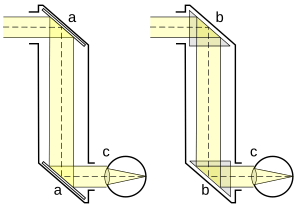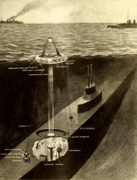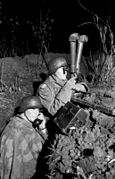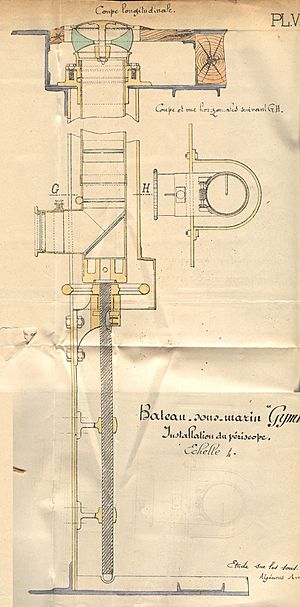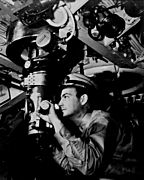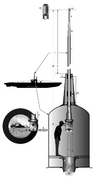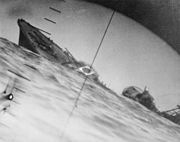Periscope facts for kids
A periscope is a cool tool that lets you see things that are normally blocked from your view. Imagine looking over a wall, around a corner, or through something without actually moving!
The simplest periscope uses two mirrors. These mirrors are placed at each end of a tube, tilted at a 45-degree angle. This basic design was very useful in the trenches during World War I to help soldiers see without putting themselves in danger. Today, periscopes are still used in military vehicles like tanks and armored cars.
More advanced periscopes use prisms or fiber optics instead of mirrors. These can even make things look bigger, like a telescope! You'll find these complex periscopes on submarines and in many science fields. A classic submarine periscope is like two telescopes pointing at each other.
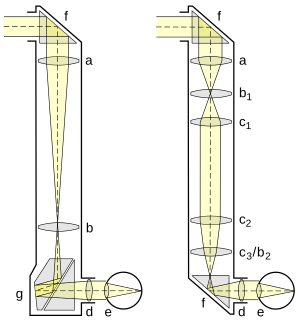
a Objective lens
b Field lens
c Image erecting lens
d Ocular lens
e Lens of the observer's eye
f Right-angled prism
g Image-erecting prism
Contents
Who Invented the Periscope?
People have been thinking about periscopes for a long time!
- In 1647, Johannes Hevelius described an early version with lenses. He called it a "polemoscope" and thought it could be used in wars.
- The first naval periscope was invented in 1854 by Hippolyte Marié-Davy. It was a simple tube with two mirrors.
- Simon Lake used periscopes in his submarines as early as 1902.
- Sir Howard Grubb made the device even better during World War I.
Periscopes in World Wars
Periscopes played a big role in both World War I and World War II.
During World War I (1914–1918), soldiers used periscopes to see over the top of their trenches. This kept them safe from enemy fire, especially from snipers. There was even a special periscope rifle. This rifle had a periscope attached, allowing soldiers to aim and shoot from a safe spot below the trench wall.
In World War II (1939–1945), military observers and officers used special periscope binoculars. Some of these could even help them figure out how far away a target was.
- Early examples
-
Australian Light Horse troops using a periscope rifle in 1915.
Periscopes in Armored Vehicles
Tanks and other armored vehicles use periscopes so that drivers, commanders, and other crew members can see outside. Before periscopes, these vehicles had small slits cut into the armor for vision. But these slits made the armor weaker. Periscopes allow people inside to see out without needing weak spots in the strong armor, keeping everyone safer.
Sometimes, a periscopic device in an armored vehicle is called an episcope. An episcope is usually fixed in place, while a periscope can often rotate to give a wider view.
Gundlach and Vickers 360-Degree Periscopes
A very important invention was the Gundlach rotary periscope. Patented in 1936 by Rudolf Gundlach, this periscope could rotate. It also had an extra prism that could flip the view. This meant a tank commander could see all around (360 degrees) without moving their seat, even seeing behind them!
This design was first used in the Polish 7-TP light tank. The patent was later sold to Vickers-Armstrong in Britain. They developed it further for British tanks like the Crusader and Churchill. The technology was also shared with the American Army for tanks like the Sherman. Even the Soviet Union and Germany copied the design for their tanks, including the famous T-34.
Periscopic Gun-Sights
During World War II, periscopes were also used to help aim guns. These "periscopic sights" were linked to the gun itself. This allowed the gunner to aim accurately while having a much better view of their surroundings than with older sights.
Modern Tank Periscopes
Today, special periscopes can even provide night vision. Some modern periscopes, like the Embedded Image Periscope (EIP), can show digital images from cameras and sensors right inside the unit. This means the crew can see thermal images or low-light views comfortably.
Periscopes for Submarines
Periscopes are super important for submarines. They let a submarine, when it's not too deep, look for other ships or threats on the surface or in the air. When not in use, the periscope slides back down into the submarine's hull.
Submarine commanders have to be careful when using a periscope. It creates a visible ripple on the water and can even be detected by radar. This could give away the submarine's hidden position.
- In 1854, Marie-Davey built a simple naval periscope.
- Thomas H. Doughty of the United States Navy later made a version with prisms during the American Civil War.
- Captain Arthur Krebs added two periscopes to the French submarine Gymnote in 1888 and 1889.
- The Spanish inventor Isaac Peral also put a fixed periscope on his submarine Peral in 1888.
- The idea of a periscope that could collapse and retract for submarine warfare is usually credited to Simon Lake in 1902. He called his invention the "omniscope."
Modern submarine periscopes are like advanced telescopes. They use prisms instead of mirrors because prisms are tougher. They can also help with measuring distances and targeting. The parts of a submarine periscope need to be very strong to handle the force of moving through water. They might even hold a radio or radar antenna.
Traditionally, submarines had two periscopes:
- A navigation periscope, used for scanning the sea and sky. It usually had a wide view and low magnification.
- A targeting or "attack" periscope, used for aiming. It had a narrower view and higher magnification. In older submarines, this was the only way to get target information for firing torpedoes.
Today, some modern submarines, like the US Navy's Virginia-class and the Royal Navy's Astute-class, don't even use traditional periscopes anymore! Instead, they have photonics masts. These masts lift electronic sensors above the water. The signals from these sensors travel electronically to screens inside the submarine. This is safer and allows for more freedom in designing the submarine's inside.
- Naval use
See also
 In Spanish: Periscopio para niños
In Spanish: Periscopio para niños


